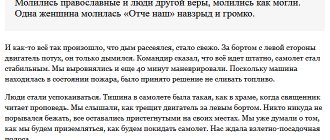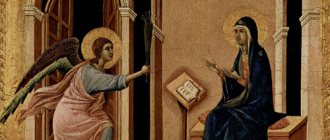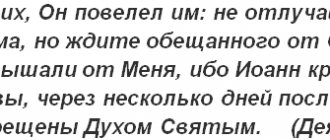In the Christian faith, the Lord's Prayer is the main, strongest and oldest of all. It was this that Christ left for his apostles, which was mentioned in the Bible - in their Gospels, Matthew and Luke, and on the walls of the temple on the Mount of Olives the prayer was carved in 140 languages from all over the world.
Traditionally, Orthodox prayers are read in Church Slavonic, but there are versions in modern Russian speech. As Simeon the New Theologian noted back in the 9th-10th centuries, a petition will only reach the Lord when the person asking him understands what he is asking Him for. If a Christian believer, according to all the rules, reads the Lord’s Prayer three times a day, saying “who art in heaven” and “Thy kingdom come,” but does not do it from the heart, but because it is necessary, but in fact does not understand what this means and how to go about this, prayer will not have its miraculous power.
In Orthodox Christianity, due to the difference in translations of the Bible and the Lord’s Prayer, there are disputes and misinterpretations, as if only one of them is true. There is no doubt - both prayers mean the same thing, they are just said in different words. You should resort to the prayer that is completely clear and close to you, and then it will protect you and your family from adversity and give God’s blessing.
Full text of the Lord's Prayer in Russian
The modern version of the reading is no worse than the canonical one for the Orthodox Church, but is much clearer and easier to remember. This is especially important for children, for whom simple modern Russian words are natural, but the ancient church dialect is not remembered at all.
Our Father! Who is in heaven!
Hallowed be Thy name, Thy kingdom come,
Thy will be done on earth as it is in heaven;
Give us this day our daily bread;
And forgive us our debts, as we forgive our debtors;
And do not lead us into temptation, but deliver us from evil.
For Yours is the kingdom and the power and the glory forever!
Amen.
You can also print out the text of the Our Father prayer to carry with you and read when you feel the need.
Or you can save the photo picture below, which also contains the words of the prayer:
The article collects and arranges in chronological order the known translations of the text “Our Father” into the Chuvash language starting from the second half of the 18th century. up to modern translations of the 21st century. The presented linguistic analysis allows us to draw conclusions that the translations of “Our Father” to one degree or another reflect the stages of the development of the written Chuvash language.
Key words: “Our Father”, Chuvash language, pre-Yakovlev period, Yakovlev period, translation
This article collates the known translations of the Lord's Prayer into the Chuvash language in chronological order from the latter 18th to the early 21st century. The texts are accompanied by linguistic analysis. The article concludes that these translations of the Lord's Prayer reflect various stages of the development of the Chuvash literary language.
Key words: Lord's Prayer, Chuvash, Yakovlev, Bible translation
Introduction
The history of the Chuvash literary language is usually divided into two periods: · Old written (pre-Yakovlev) - 1769–1871; · new written (Yakovlevsky) - since 1871. The pre-Yakovlev period is not sufficiently covered by Chuvash philologists. The rare works on this topic published in Soviet times suffer from ideological bias. For example, well-known linguists V.G. Egorov [1949], N.P. Petrov [1964] believe that the role of early written monuments - translations from Church Slavonic, Russian and German, carried out in the pre-Yakovlev period, is insignificant, since they were literal interlinear translations and were not at all accepted by the Chuvash. In fairness, it should be noted that an objective, scientific approach is observed in the studies of such scientists as N.V. Nikolsky, G.I. Komissarov, S.P. Gorsky, L.P. Sergeev and others. In post-Soviet times, significant gaps in in this area, researchers such as A.V. Savelyev, Oguzkhan Durmush, O.R. Students and others contributed to the study of this period. Of particular note is the work of Oguzkhan Durmush [Durmuş 2014], written in Turkish, where all known written monuments of the Chuvash language of the 18th century. and a complete dictionary is provided. The book also contains a small section devoted to the translation of the Lord's Prayer. In this article, we have attempted to describe the history of all available translations of the Lord’s Prayer into the Chuvash language, followed by linguistic analysis. At the same time, we deliberately limit the topic to only the translation of “Our Father,” since a review of literature on the Old Chuvash period of Chuvash writing is a separate extensive topic. The purpose of this article is, using the example of the translation of one prayer, to show the process of formation and development of the Chuvash literary language and writing (late 18th – early 21st centuries), as well as the difficult path of the formation of church style and basic concepts of the Bible in the language. In our opinion, the stable text of the original prayer “Our Father” accompanies a more or less objective assessment of translations.
The full version of the article by P.Ya. Yakovlev, see attached file.
From the editor
The first issue of the journal “Native Language” for 2022 is noteworthy in several respects. Firstly, this is the tenth anniversary issue of the magazine. Secondly, the issue is published in the year when the 70th anniversary of the birth of M. E. Alekseev, the initiator of the creation of the magazine “Native Language” and its first editor-in-chief (No. 1, 2013), is celebrated. Thirdly, the central place in this issue is occupied by the heading “Linguistic Aspects of Bible Translation.” The articles collected in this section are united by one topic - linguistic analysis of translations of the Lord's Prayer (from the Gospel of Matthew 6:9-13), also known as “Our Father”, into the languages of Russia and neighboring countries: Chuvash (P. Ya. Yakovlev ), “Karachai” and “Nogai” (O. A. Mudrak), Abkhaz (J. Hewitt), Dargin and Kubachi (O. I. Belyaev), Udin (T. A. Maysak), Finnish, Komi-Zyrian and Komi-Permyak (M. Alholm, A. Kuosmanen) . The articles represent the analytical part of the project of the Institute of Bible Translation (IBT), which was started some time ago - a multilingual publication of translations of the Lord's Prayer into the languages of the Russian Federation and the post-Soviet space. This will be the third multilingual publication of the IPB, after “The Nativity of Jesus Christ” from Luke 2:1-20 (2000) and “In the beginning was the word” from John 1:1-17 (2008, 2011) .). The Lord's Prayer is presented in two Gospels: Matthew (6:9-13) and Luke (11:2-4). These two texts are known as the long and short versions of the Lord's Prayer. The choice of the IPB for the multilingual edition settled on the long version of the Prayer from Heb. from Matthew, which for many centuries has been accepted in the liturgical practice of all Christian denominations. In contrast to the liturgical tradition, the IPB publishes the text without the ending of verse 6:13 - doxology, that is, praise, which is not represented in the most ancient Greek manuscripts and is, according to most modern biblical scholars, a later insertion into the text of Heb. from Matthew. It should be noted that the multilingual edition will include not only the texts of the Lord's Prayer from previously published translations of Ev. from Matthew, but also new translations specially prepared for this edition (for example, Kubachi, Ket, etc.). Another important distinctive feature of the publication is that the texts will be accompanied by Russian and English interlinear translations and a review and analytical part. In anticipation of the multilingual publication, “Native Language” publishes articles devoted to a comparative linguistic analysis of translations of the Lord’s Prayer by different authors and different eras, as well as a historical overview of some translations of the Lord’s Prayer.
Beware of fake: “literal” translation of the Lord’s Prayer from Aramaic
While traveling through the Internet, I came across one interesting note: “A literal translation of the Lord’s Prayer in Aramaic.” I was interested in the name itself and, having opened the link, began to look for this prayer. To my surprise, I found something that I was not looking for, something that, in my opinion, went beyond the truth.
The translation of the Lord's Prayer from Aramaic into Russian was as follows:
“O Breathing Life, Your Name shines everywhere! Make space to plant Your presence! Imagine in your imagination your “I can” now! Clothe Your desire in every light and form! Grow through us bread and Insight for every moment! Untie the knots of failure that bind us, Just as we release the ropes with which we hold the misdeeds of others! Help us not to forget our Source. But free us from the immaturity of not being in the Present! From You arises every Vision, Power and Song From meeting to meeting! Amen. Let our next actions grow from here.”
I could not believe my eyes, my spirit resisted accepting, reading such, I will not hesitate in expressions, nonsense that the author presented as a literal translation of a prayer from Aramaic into Russian. I looked at various links on the Internet and was amazed at how many links said the same thing. People ignorantly copy the text and share it with others, passing it off as some kind of secret truth. Reading this “translation”, for some reason, I immediately remembered the Gnostics (a heretical sect of the 1st-2nd centuries AD), who propagated a certain secret teaching of Christ, giving enlightenment to man and an understanding of all things, and pantheism (heresy of the 4th century AD, exists to this day).
One of the authors who posted this nonsense on the Internet claimed that Aramaic was the dominant and primary version of the written text of the New Testament. The Peshitta (the Syriac translation of the Bible, an Aramaic dialect) was based on the translation of the Aramaic Targum, which means the Greek version of the New Testament was later than the Peshitta, and was only a translation from the Aramaic language, the same one that was native to Jesus Christ and the apostles. In other words, the Greek version is not primary. Assuring readers, the author shares a false “translation from the original language” into Russian.
Before we get into the actual separation of flies and cutlets, let me remember a little from Christian history:
There are several ancient translations of the Holy Scriptures into various languages: the Septuagint - a Greek translation of the Old Testament, the Targums - a general name for translations of the Old Testament into Aramaic, the Vulgate - a translation of the Bible into Latin, and the Peshita - one of the translations of the Bible into Syriac (Edessa dialect of Aramaic language). The author's hypothesis, according to which the Peshitta was based on a translation of the Aramaic Targum, does not stand up to criticism and does not receive the support of theologians, scientists, and history. However, elements of Targum influence are observed in the text of the Syriac Old Testament (especially in the Pentateuch of Moses and Chronicles). But the style and level of translation of the Old Testament books of the Peshitta varies quite a lot in different parts of Scripture. Some parts of it may have been translated by Syriac-speaking Jews before the emergence of the Christian Church, while others may have been revised by the first baptized Jews.
Speaking about the Aramaic language, it should be noted that in the Hellenistic era and up to the Arab conquest, it successfully competed with Greek, reserving the role of local dialects for all other Semitic languages. But from the 2nd century, the ancient Aramaic language, in which the entire Middle East, including Egypt, was spoken, underwent changes and strong modifications under the influence of various cultures and subsequently the conquest of the Arabs (7th century AD).
Historically, it should be noted that the books of the Old Testament were translated into Syriac in the last quarter of the 2nd century AD. BC, the New Testament books were translated by the beginning of the 5th century AD. and were apparently grouped and revised by the Bishop of Edessa, Rabbula. That is, by the 5th century AD, the Peshita as such had already been formed (the very name “Peshitta”, in relation to the standard (generally accepted) Syriac Bible, appeared only in the 9th century AD).
But refuting the historicity, there are still people who claim that the entire teaching of Christ and the apostles was taught only in Aramaic, and it was this language, being the language of the original text, that preceded the text of Scripture in the Koine Greek dialect. It is also surprising that this position is mainly adopted by those who share the views of Nestorianism (the heresy of the 4th century, dividing Christ into a simple man before baptism and the Son of God after that, i.e., rejecting one single person and hypostasis).
Studying biblical studies, we remember that there is a synoptic problem (similarities and differences in the Gospels). And today there is no firm belief as to why it exists, there are only various hypotheses, each of which has its own pros and cons. Today, one of the most realistic hypotheses is that Matthew and Luke, when writing the gospel, used a certain source “Q”, from the German “Quelle” (source), whether this source was part of the sayings of Jesus Christ in Aramaic or not, it is not known, although some of the sayings of Jesus in the Gospels are translations from Aramaic, but be that as it may, it is believed that the text of the Gospel in its current form was compiled in Greek, like other texts of the New Testament. In addition, the Greek language of the books of the New Testament was accepted by the Church Fathers as the original language of the texts, without any discussion. There is a lot of other evidence that it was Koine (a dialect of the Greek language) that was the original text of the New Testament. I would also like to note that to this day not a single manuscript of passages of the books of the New Testament in Aramaic has been found, the text of which would date earlier than the Greek Koine New Testament.
Having remembered a little history, we understand that no “original text in Aramaic” has been found (based on my convictions, it does not exist, because God allowed Scripture to be formed in the form in which we see it, have it, and with the language found in ancient manuscripts). Now about the “Our Father” prayer and the author of this “translation”. To do this, let us again turn our attention to the “literal translation from Aramaic” presented to us:
“O Breathing Life, Your Name shines everywhere! Make space to plant Your presence! Imagine in your imagination your “I can” now! Clothe Your desire in every light and form! Grow through us bread and Insight for every moment! Untie the knots of failure that bind us, Just as we release the ropes with which we hold the misdeeds of others! Help us not to forget our Source. But free us from the immaturity of not being in the Present! From You arises every Vision, Power and Song From meeting to meeting! Amen. Let our next actions grow from here.”
To begin with, it should be noted that the prayer “Our Father” was written in ancient Greek, and this translation is only a kind of “crooked reconstruction of the meaning” with deliberate misleading of the reader. We know that there are fragments, as part of the sayings of Christ, translated from Aramaic, one of such fragments is the prayer of Christ on the cross of Calvary, but among all the fragments familiar to us, there is not a single mention of the “Lord’s Prayer” in Aramaic.
In addition, in ancient Aramaic, as well as in ancient Hebrew and ancient Greek, addressing God always came in conjunction with masculine personal pronouns, but not feminine or neuter. Is it possible to imagine that a patriarchal culture, where the leading and dominant role in the family, state and politics belonged to men, suddenly allows an appeal to God as some unknown force of the feminine gender, without personality? Of course not! Not one Jew of a monotheistic religion, brought up in a patriarchal culture, who knows the books of the Law, will never allow himself to turn to God the Creator, as the author of this “translation” of the Lord’s Prayer suggests to us.
We say and understand that Scripture is interpreted only by Scripture. Jesus, in his teaching, repeatedly drew the attention of His disciples to the Father, from Whom He descended and to Whom He is coming again. He spoke about the Father's love in deeds, parables, in the history of the people, in Scripture. He emphasized His unity with the Father, but the Person of the Father as predominant in the Trinity. He never taught that the Father can be addressed as some unknown force. The Russian word “Father (parent)”, in Aramaic as well as in Hebrew, sounds like “Aba (Abba)”, in Greek “Pater”. Addressing God the Father as “Our Father” sounds like “Avinu” in Hebrew and “Avvun” in Aramaic. But what is surprising is that not once did the author of the so-called “translation” of the Lord’s Prayer use the word Father, and yet it is the main and central word in this prayer. On the contrary, I believe that the word “father” was deliberately omitted to show the false “greatness” of a literal prayer devoid of all meaning and the power of the Spirit, passing it off as a secret truth! Based on the teachings of Christ, we see how this “translation” destroys the essence of God the Father as a Person, presenting him as some kind of force, thereby undermining the relationship within the Trinity and with people. Presented to the masses, the so-called “translation” of the Lord’s Prayer is nothing more than a heresy, a fusion of Gnosticism and pantheism, a heresy with which the Church has struggled for centuries. Currently, one can see this fusion in movements such as the “New Age” (“New Age”), which with all its might declares the syncretism of religions, the destruction of true Christianity, and the rejection of the Christian idea of a personal God the Creator, contrasting it with the idea of an impersonal deity.
Now, as for the author himself who made this “translation” and threw it into the world: The author of this “translation” is a doctor of religious studies and somatic (body-oriented) psychology Saadi Neil Douglas-Klotz (Murshid Saadi Shakur Chishti). His main interests lie in the integration of ancient meditation techniques with modern psychology and body science. He is a specialist in the field of Middle Eastern mysticism, the author of several books devoted to the study of the so-called original message contained in the primary sources of the world's religions - “Prayers of the Cosmos: a meditation on the words of Jesus spoken in Aramaic” (by the way, it is likely that this presented “translation” is an excerpt from that very book), “The Wisdom of the Deserts,” “The Hidden Gospel,” “The Sufi Book of Life.”
Murshid Saadi (Neil Douglas-Klotz) is one of the senior teachers of the Ruhaniat Sufi order (Sufi Ruhaniat International), following the so-called “Sufi path” for about 30 years. In Russia he is known as one of the founders of the Universal Peace Dance Network. Using the Sufi technique of Zikr (the practice of remembering one's true nature, using meditation and chanting) and dancing using mantras from various religious and national traditions, he proposes to “establish a person’s real contact with himself, both with his depths and with his heights ..."
God is a Just Judge, He will judge everyone who rejects Christ as Savior and personal Lord. God will judge everyone who leads a person astray from the true path, passing off lies as truth. But no one removed responsibility for our salvation from us, as Christians who follow the Lord, no matter who or what we met along the way. Satan has not stopped walking around like a roaring lion, looking for someone to devour!
Studying the “literal translation of the Lord’s Prayer” offered for everyone to see, I also noticed that it is distributed mainly not on Christian resources, but on various heretical ones that have their affiliation with the “New Age” or share views with it - sites on mysticism , esotericism, meditation, parapsychology, talking about some secret teachings and truth. Some distribute these texts by copying them on the pages of their websites and blogs, others through statements in social network statuses. The surprising thing is that Christians, reading these texts, without delving into the very essence of what they are reading, themselves continue to spread this nonsense on the Internet, passing it off as truth, and others, echoing them, send it further. The spreading infection settles not only on the Internet, but also in the minds of many people. Some Christians, reading the text, manage to leave flattering comments on it like: “Cool,” “Amen.” It’s true,” “Thank you for the literal translation, now I’ll know.” What do you know? Why shout Amen? What's cool? They read and shout without knowing the Scriptures or the power of God! It’s a shame to eat everything without understanding what they feed you! (sorry for the directness of expression).
Now, knowing a little about the history of translations of Scripture and the author of this “translation” of the Lord’s Prayer, I think it is not difficult to understand that the so-called “literal translation of the Lord’s Prayer” distributed on the Internet has nothing in common with the real prayer of Christ, but is only a heresy, deliberately aimed at undermining Christian doctrine and destroying Christianity as a whole!
Due to the fact that the ancient Aramaic language is considered dead (Aramaic (the new Aramaic dialect) is spoken only in Syria), a rough translation of the Lord's Prayer in it would look like this:
“Avvun dbishmaya! nitkaddah shimmukh; aunt of the little boy; neve sovyanukh eichana dbishmaya ab para; Ha la lahma dsunkanan yumana; Vushuh lan khobein, eichana dap akhnan shuklan hayavin; vula taalan lnisyuna, ella pasan min bisha. Mudtul dilukh hai malchuta, uheyla, utishbukhta l'alam allmin. Amine". (Our Father who art in heaven! Hallowed be Thy name; Thy kingdom come; Thy will be done on earth as it is in heaven; give us our daily bread this day; and forgive us our debts, as we forgive debtors ours; and lead us not into temptation, but deliver us from evil. For Thine is the kingdom and the power and the glory forever. Amen.)
To summarize what has been said, I would like to encourage everyone to comprehend everything we read. Dear friends, there are a lot of things being spread on the Internet, both good and bad, watch what you read and spread. Do not distribute the so-called “literal translation of the Lord’s Prayer” online, or in any other way, do not pass it off as a lost truth, it has neither the depth nor the power of the Spirit! After all, there will be those who are weak, who do not understand, who read everything and swallow everything they read, who cannot separate the wheat from the chaff, those who will be tempted, who will believe, and as a result may fall away, because... will allow doubts to settle in his heart. And the Lord will ask us for this.
Christ left everything we need in the Scriptures, transmitted through the patriarchs, prophets, and apostles! Do not mislead the weak sheep, do not think that there is some hidden meaning where there is none. When analyzing sermons, references, texts, people's statements, check them with Scripture, is it exactly as it is presented? Remember at least the fragments of the New Testament: “Those here were more thoughtful than those in Thessalonica: they received the word with all diligence, daily examining the Scriptures to see if this was exactly so” (Acts 17:11), “Pay attention to yourself and to the teaching; do this constantly: for by doing this you will save both yourself and those who listen to you” (1 Timothy 4:16).
Knowing the truth, let us hold fast to the Scripture, neither turning to the right nor to the left!
Sergey Rostovtsev
— See more at: https://baznica.info/article/ostorozhno-falshivka-bukvalnyj-perevod-otche-nash-/#sthash.HX6Cb5Vh.dpuf











